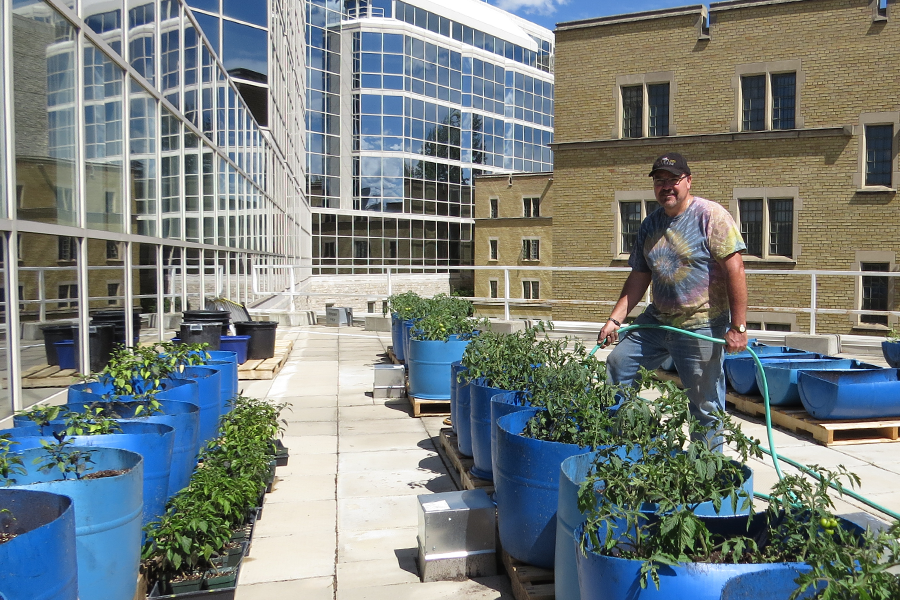
Rooftop roots
A rooftop garden project promoting sustainable agricultural practices and urban farming is sprouting on campus this summer.
By Lesley Porter“This is the other face of agriculture—urban agriculture,” said Grant Wood, a professor in the College of Agriculture and Bioresources.
Tomatoes, hot peppers and leafy greens (including lettuce, kale and spinach) will soon be popping up on the roof of the phytotron, a sunny, triangle-shaped area visible from the above-ground walkway between the biology and agriculture buildings.
“We might try a few other things, too,” said Wood. “I want to try zucchini, just to see. They’re a warm season crop—it could be fun! We’re going to try some cucumbers as well and see how they respond.”
Wood, who teaches a class on urban food production in the Department of Plant Sciences, is no stranger to rooftop gardens. He worked alongside Diane Knight (from the Department of Soil Sciences) to develop a garden atop the Stadium Parkade two years ago. So while the idea is not an inherently new one, this is one of the first where food production to supply Culinary Services is the overall goal, he explained.
Additionally, other groups on campus are involved to ensure as little waste as possible from the process. Facilities Management Division (FMD) operates a compost, and the resulting product from that will be used in the planters to help grow the food. Once the vegetables are harvested, they are sold to Culinary Services to feed hungry students and other campus visitors. Culinary Services also operates a large-scale food dehydrator, which dries down any waste products and gives it back to FMD for their compost, which can be used again in the planters. And so the cycle continues.
“We’ve got the loop—not many universities in Canada do that,” said Wood.
The project is a testament to urban farming. Wood added that a third of the degree students in the College of Agriculture and Bioresources are graduates from urban high schools. “They see agriculture through different eyes than rural students.”
Local food production is also of great importance. “We talk food miles—this is food feet. It’s physically less than a mile from Culinary Services to the compost at FMD,” he said.
And it is not just in Saskatchewan, an agricultural epicenter. He cited New York City-based Brooklyn Grange—one of the larger rooftop farming ventures in North America—as another notable example of urban agriculture. “They harvest the veggies, send them down the elevator and next door to the restaurant. The waiter comes and says, ‘Here’s your salad, ma’am. It was picked ten minutes ago.’”
In addition to keeping waste minimal, this practice is also relatively inexpensive—the main costs are labour, water, soil and seeds, he said. Bioriginal Food and Science Corp., a local food research group, donated containers for the plants and wooden pallets for them to rest on. The compost from FMD is, of course, free.
The garden is tentatively planned for five years. If all goes well after this summer, the garden may expand to the roof area on the other side of the tunnel—though shadier, it still holds a lot of potential, he said.
“We can grow veggies in urban settings. This is just one other place to grow them.”

